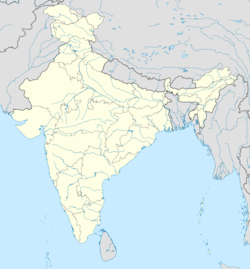Aurangabad, West Bengal
Aurangabad | |
|---|---|
Census Town | |
| Coordinates: 24°36′04″N 88°02′01″E / 24.6012°N 88.0336°ECoordinates: 24°36′04″N 88°02′01″E / 24.6012°N 88.0336°E | |
| Country | |
| State | West Bengal |
| District | Murshidabad |
| Government | |
| • Type | Federal democracy |
| Area | |
| • Total | 2.77 km2 (1.07 sq mi) |
| Population (2011) | |
| • Total | 39,261 |
| • Density | 14,000/km2 (37,000/sq mi) |
| Languages | |
| • Official | Bengali, English |
| Time zone | UTC+5:30 (IST) |
| PIN | 742201,742224 |
| Telephone/ STD code | +913485 |
| ISO 3166 code | IN-WB |
| Vehicle registration | WB-57, WB-58, WB-94 |
| Lok Sabha constituency | Jangipur |
| Vidhan Sabha constituency | Suti |
| Website | murshidabad |
Aurangabad is a census town in the Suti II CD block in the Jangipur subdivision of the Murshidabad district in the Indian state of West Bengal.[1][2]
GeographyEdit
LocationEdit
Aurangabad is located at 24°36′04″N 88°02′01″E / 24.6012°N 88.0336°E.
According to the map of Suti II CD block in the District Census Handbook, Murshidabad, Dafahat, Jagtaj, Debipur, Aurangabad, Hafania, Mahendrapur, Paschim Punropara, Bhabki, Khidirpur, Khanpur, Ichhlampur, Chakmeghoan and Kakramari, form a cluster of census towns.[3]
DemographicsEdit
According to the 2011 Census of India, Aurangabad had a total population of 39,261, of which 19,474 (50%) were males and 19,787 (49%) were females. Population in the age range 0-6 years was 6,529. The total number of literate persons in Aurangabad was 21,027 (64.24% of the population over 6 years).[4]
As per 2001 Census of India[5] Aurangabad had a population of 32,134. Males constitute 50% of the population and females 50%. Aurangabad has an average literacy rate of 44%, lower than the national average of 59.5%: male literacy is 52%, and female literacy is 36%. In Aurangabad, 19% of the population is under 6 years of. Aurangabad also includes Mahendrapur village which has a population of 6979.
InfrastructureEdit
According to the District Census Handbook, Murshidabad, 2011, Aurangabad covered an area of 2.77 km2. The protected water-supply involved overhead tank, tube well, borwell. It had 3099 domestic electric connections. Among the medical facilities it had 5 dispensaries/ health centres, 11 medicine shops. Among the educational facilities, it had 18 primary schools, 1 middle school, 2 secondary schools, 2 senior secondary schools, 1 general degree college. It had 1 recognised shorthand, typewriting, vocational training institution. Among the social cultural and recreational facilities it had 1 stadium, 1 auditorium/ community hall. It produced beedi, spices, handloom. It had branches of 2 nationalised banks, 1 private commercial bank.[6]
EducationEdit
College
Dukhulal Nibaran Chandra College of Aurangabad is recognized by UGC.[7]
Schools
Aurangabad High School (H. S) of Aurangabad is maintained by the 'National University of Educational Planning and Administration' under the program 'District Information System for Education 2013-2014.[clarification needed]
Aurangabad Balika Vidyalaya
Chhabghati K.D. Vidyalaya (H.S.)
English Oriental Academy, CBSE Board
Aurangabad High Madrasah (H.S)
Ideal Education Mission School
Nimtita G. D Institution
Panchagram I. S. A High School
Aurangabad PTTI
Aurangabad Public School
Altab Hossain PTTI
As Sabin Mission
ARTM Public School
Prabananda Vidyapith
Gurukul Sikhsha Niketan
Other institutions
Jakir Hossain Institute of Polytechnic
Aurangabad B.Ed College
Nathulal Das B.Ed College
Am Teacher's Training college
Aurangabad B.Ed Training College
J.S B.Ed College
IndustryEdit
HealthcareEdit
Aurangabad has a Primary Health Centre (PHC).[9]
Suti II CD block is one of the areas of Murshidabad district where ground water is affected by a high level of arsenic contamination. The WHO guideline for arsenic in drinking water is 10 mg/ litre, and the Indian Standard value is 50 mg/ litre. The maximum concentration in Suti II CD block is 1,852 mg/litre.[10]
Electoral constituenciesEdit
Aurangabad was assembly constituency No. 51 of West Bengal; later as recommendations of Delimitation Commission were implemented, this area was part of new assembly constituency No. 57, Suti, which will contain the whole area under Suti I and Suti II CD Blocks.
ReferencesEdit
- ↑ "Population, Decadal Growth Rate, Density and General Sex Ratio by Residence and Sex, West Bengal/ District/ Sub District, 1991 and 2001". West Bengal. Directorate of census operations. Archived from the original on 28 September 2011. Retrieved 13 November 2008.
- ↑ "Census of India 2001, Final Population Totals, West Bengal, Rural Frame". West Bengal. Directorate of census operations. Archived from the original on 19 July 2011. Retrieved 13 November 2008.
- ↑ "District Census Handbook Murshidabad, Census of India 2011, Series 20, Part XII A" (PDF). Page 195, Map of Suti II CD block. Directorate of Census Operations, West Bengal. Retrieved 1 July 2021.
- ↑ "C.D. Block Wise Primary Census Abstract Data(PCA)". West Bengal – District-wise CD Blocks. Registrar General and Census Commissioner, India. Retrieved 27 August 2017.
- ↑ "Census of India 2001: Data from the 2001 Census, including cities, villages and towns (Provisional)". Census Commission of India. Archived from the original on 16 June 2004. Retrieved 1 November 2008.
- ↑ "District Census Handbook Murshidabad, Census of India 2011, Series 20, Part XII A" (PDF). Section II Town Directory, Pages 981-987: Statement I: Growth History, Pages 990-993: Statement III: Civic & Other Amenities, Pages 993-995: Statement IV: Medical Facilities 2009, Pages 995-1001 Section V: Educational, Recreational and Cultural Facilities; Pages 1001- 1002: Statement VI: Industry & Banking. Directorate of Census Operations, West Bengal. Retrieved 26 June 2021.
- ↑ "List of Colleges in West Bengal". University Grants Commission (India). Archived from the original on 16 July 2011. Retrieved 13 November 2008.
- ↑ "Tourism". Official website of Murshidabad district. Archived from the original on 17 December 2008. Retrieved 13 November 2008.
- ↑ "Staff particulars of MO in the district of Murshidabad: Government Hospitals Details" (PDF). Official website of Murshidabad district. Archived from the original (PDF) on 27 July 2011. Retrieved 13 November 2008.
- ↑ "Groundwater Arsenic contamination in West Bengal-India (20 years study )". Murshidabad. SOES. Retrieved 4 August 2017.

